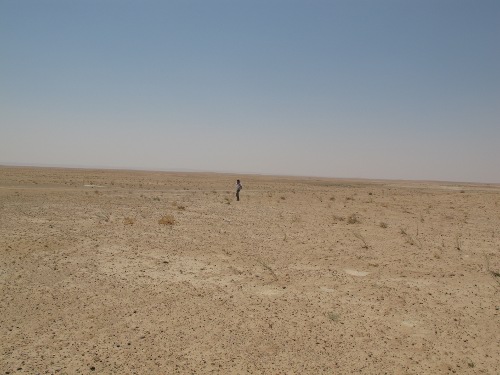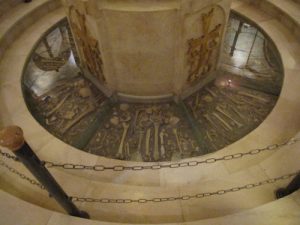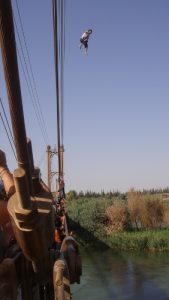Der Zor: The Killing Fields
As we circled closer and closer to Der Zor, and with each community we visited, we went deeper and deeper into the Armenian consciousness. In mid-August, we reached the epicenter — to which countless thousands of uprooted Armenians had been driven to their deaths.
I stood on Der Zor’s blanched desert sands with nothing visible around us. Every fact and figure I had read, learned and memorized about the Armenian Genocide seemed to vanish. I could think only of the bleakness, the barrenness, the blinding sun and searing heat of August — and how sentient beings had been deliberately herded to this inferno of nothingness to suffer and expire.
As I stood apart from the group, the atmosphere held a transcendent significance. We had been given the rare opportunity to viscerally sense the thirst, hunger and agony that our martyrs and survivors had endured. The reverence I had for the tormented souls who had their final release here left me oblivious to physical discomforts in the present. In fact, we arrived just two days shy of the 95th year of British statesman Viscount Bryce’s reporting that caravans of Armenians started to arrive in Der Zor.
Many voyagers in the modern day have scratched and sifted the surface of Der Zor and found the skulls and bones of the murdered Armenians. Today, the land is still bare and unoccupied on the surface, and misery seems to cling to the dry, hot air. I thought about how the beaten bodies of our ancestors found eternal respite here, even if their spirits did not. I stared at the sand and, through my tears, quietly sang “Hahnk-jeh-tsek,” or “May You Rest,” an Armenian repose of the souls. Turkey continues to claim that it had merely “relocated” Armenians to Der Zor. Yet who could survive in this abysmal place? Relocation meant death, just as Turkey intended. Before we scrambled back on the bus, I collected sand and tumbleweed so that my contemporaries back in America could recall Der Zor in a tangible way.
Ghosts of the Euphrates
Several kilometers from the Der Zor desert, our group gathered on a suspension bridge over the Euphrates River where many Armenians had met their end. A dozen or so local Syrian boys seemingly seeking amusement and relief from the heat had perched themselves about 25 meters above the water, on the rails and cables of the bridge. As we ceremoniously tossed flowers into the Euphrates, these boys began to jump into the river. Their acts recalled for many of us the Armenian girls and women who, during the Genocide, committed suicide by flinging themselves into these very waters to avoid rape and abduction by Turks. Remembering this and seeing the boys jump, I could barely get the words out as the Vicar led our group in song:
Gooys aghcheegner (Armenian virgins)
Eeraroo tzerk purnetzeen (holding each others’ hands)
Eerenk, zeerenk (as they in unison)
Yeprad Kedn nedetzeen (threw themselves into the Euphrates)
Could these local boys, the eldest of whom were just teenagers, have known the significance of what they were doing? Or was it just a coincidence? To their families and the local authorities’ great regret, several youths had in recent years died from making such colossal leaps. Were these feats somehow intended to honor our dead or were they just youthful bravado? I was too unsettled by what we were witnessing at the time to ask more than a handful of people, who did not know.
To somehow mitigate my heartache over what I had seen, I walked further along the bridge, my arms clinging to my torso for solace. As I leaned over to peer through my tears at the River below, some postcards of rescued Armenian treasures from Cilicia fell from my diary and sailed down the Euphrates. At the time, I felt I had unwittingly littered the River. But later, it occurred to me that the postcards may have had a mind of their own and sought to trail after and comfort the souls who had not been saved.
There is a saying that the Euphrates looks clear and bright to everyone but Armenians who, when they gaze upon it, see only murky greens and browns. As an Armenian who has now been there, I can vouch for that saying. Even so, I suppose I should feel grateful that the Euphrates did not appear to run red from the blood of murdered innocents flung there during our ordeals.
It was only much later that my thoughts turned to personal connections to Der Zor: as a young girl my maternal grandmother Armaveni buried her own mother in those sands. And my paternal grandmother Lucia helplessly watched her two infant daughters perish in this wasteland.
In the days that followed our pilgrimage, I gradually collected my thoughts about all we had seen. I recognized that the Armenia of our ancestors was present all around us in the Levant. Two of the regions we visited in Syria — Kessab and Haleb — are long established, ancient Armenian communities. Lebanon’s Anjar and Bourj Hammoud are communities established in the early 20th century, though there have been Armenians who have lived in those regions for centuries.
On the deepest level, puzzle pieces of a dismantled Western Armenia were staring back at us: In Anjar, I found the soul: the Armenian struggle for survival and dignity. In Haleb and Bourj Hammoud, I found the spirit: the lively, vibrant Armenian community. In Kessab, I found the body: Our homelands. And in Der Zor, I found the core: The tormented remains of our ancestors.
Faith and Renewal
Many pilgrimage sites contain shrines where miracles are said to have occurred. If someone asked me what miracles I observed, I would first say that it is nothing short of a miracle that any Armenian survived the death marches into Der Zor. The second miracle was the existence of Armenian outposts in Lebanon and Syria where the Western Armenian culture, practically extinguished, persists. Bearing witness inspired me to rededicate myself to the Armenian struggle for justice. And it is my hope that by 2015 — the 100th anniversary of the Armenian Genocide — every Armenian who has not yet gone will make the pilgrimage to Der Zor.
We pilgrims owe a debt of gratitude to the people of Lebanon and Syria, who welcomed us this summer. Their governments were notified of and approved our pilgrimage. They permitted us to freely travel to sacred Christian sites and to worship and commemorate as we chose. We had full access to our own churches and community centers, which are in Armenian possession. These same nations took in refugee Armenians at the time of the Genocide, 95 years ago. Then, our exiles were permitted many rights that had been denied to them in their own native lands: to safely identify themselves as Armenians, freely speak their native language, practice their customs, honor their dead, earn a living, and build homes, schools and churches.









Bravo to the author for exposing genocide denial and educating us.
I am ashamed as an American that Turkey has yet to acknowledge its crimes and even commits new ones because the older ones were never punished.
What do you know about the “genocide”. Have you ever been to the region? Have you ever listened to other ethnic groups used to live there? Have you ever heard about the Khojaly massacre that Armenians did just 17 years ago?
I think you are right. You have to be ashamed as an American because of your past. I think you have never read about the American history or European colonization in Africa.
If you are concerning about the humanity start from yourself. During the centuries western countries colonized the current 3rd world countries and they are still using them for their own benefits. Do you really believe that US concerns about the democracy in Iraq and Afghanistan? Don’t you know that current terrorist Afghans has been militarized by America against Soviet Union before 90’s.
Yes I’m sure you have to be ashamed as an American to be a citizen of a country that is responsible for the deaths of hundreds of civilians every day in the Middle East. Where are the nuclear and chemical bombs that US officials claimed before the Iraq war. It is all about the Oil Yeah!!!
Oh yes!!!! “Energy Security of the United States” or “Democracy and Stability” :))
the turk is the same old genocidal barbarian maniac , as always. NOTHING has changed. except they’ve just gotten more EVIL.
Jack, this is exactly the sort of response that keeps this cycle going. There are Turks, but “the turk” is a straw man.
I like the website http://www.Armenian-genocide.org to get facts about the Armenian genocide. The genocide is recognized by just about everyone. Turks and a few of their friends are about the only ones who still deny it. Even a lot of Turkish scholars admit that it was a genocide.
Wonderful work! This is the type of information that should be shared around the net. Shame on the search engines for not positioning this post higher! Come on over and visit my website . Thanks =)